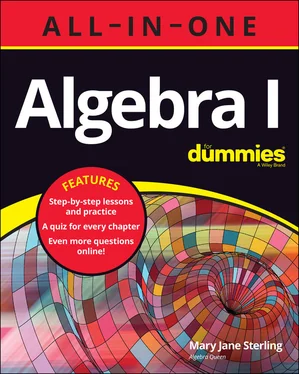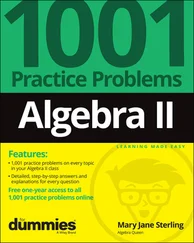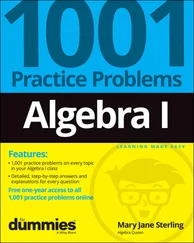If you haven’t worked on any algebra recently, I’d recommend that you start out with Chapter 1and some other chapters in the first unit. It’s important to know the vocabulary and basic notation so you understand what is being presented in later chapters.
If you’re all set with the basic operations, then a good place to go is Chapter 11, where you find out about factoring different types of expressions. Factoring makes it possible to simplify expressions and solve equations.
When you’re ready for the “What do I need this for?” question, go to Chapter 20or Chapter 21, where you see some of the many types of applications that use algebraic expressions and solutions.
There are other resources, such as Basic Math & Pre-Algebra For Dummies and Pre-Algebra Essentials For Dummies (John Wiley & Sons, Inc.), if you think you need more background. And, of course, when you’ve finished here and are ready for the next challenge, be sure to check out Algebra II For Dummies and Pre-Calculus For Dummies. And that’s just the beginning!
Book 1
Starting Out with Numbers and Properties
Contents at a Glance
1 Chapter 1: Assembling Your Tools: Number Systems Identifying Numbers by Name Placing Numbers on the Number Line Speaking in Algebra Taking Aim at Algebra-Speak Practice Questions Answers and Explanations Whaddya Know? Chapter 1 Quiz Answers to Chapter 1 Quiz
2 Chapter 2: Deciphering Signs in Expressions Assigning Numbers Their Place Going in for Operations Tackling the Basic Binary Operations Working with Nothing: Zero and Signed Numbers Practice Questions Answers and Explanations Whaddya Know? Chapter 2 Quiz Answers to Chapter 2 Quiz
3 Chapter 3: Incorporating Algebraic Properties Getting a Grip on Grouping Symbols Spreading, Grouping, and Changing the Order Relating Inverses and Identities Working with Factorial Applying the Greatest Integer Function Practice Question Answers and Explanations Whaddya Know? Chapter 3 Quiz Answers to Chapter 3 Quiz
4 Chapter 4: Coordinating Fractions and Decimals Converting Improper Fractions and Mixed Numbers Finding Fraction Equivalences Making Proportional Statements Finding Common Denominators Applying Fractional Operations Simplifying Complex Fractions Performing Operations with Decimals Changing Fractions to Decimals and Vice Versa Practice Question Answers and Explanations Whaddya Know? Chapter 4 Quiz Answers to Chapter 4 Quiz
Chapter 1
Assembling Your Tools: Number Systems
IN THIS CHAPTER
 Identifying the different types of numbers
Identifying the different types of numbers
 Placing numbers on a number line
Placing numbers on a number line
 Becoming familiar with the vocabulary
Becoming familiar with the vocabulary
 Recognizing the operations of algebra
Recognizing the operations of algebra
You’ve undoubtedly heard the word algebra on many occasions, and you know that it has something to do with mathematics. Perhaps you remember that algebra has enough stuff in it to require taking two separate high school algebra classes — Algebra I and Algebra II. But what exactly is algebra? What is it really used for?
This book answers these questions and more, providing the straight scoop on some of the contributions to algebra’s development, what it’s good for, how algebra is used, and what tools you need to make it happen. In this chapter, you find some of the basics necessary to make it easier to find your way through the different topics in this book.
In a nutshell, algebra is a way of generalizing arithmetic. Through the use of variables (letters representing numbers) and formulas or equations involving those variables, you solve problems. The problems may be in terms of practical applications, or they may be puzzles for the pure pleasure of the solving. Algebra uses positive and negative numbers, integers, fractions, operations, and symbols to analyze the relationships between values. It’s a systematic study of numbers and their relationships, and it uses specific rules.
Identifying Numbers by Name
Where would mathematics and algebra be without numbers? Numbers aren’t just a part of everyday life, they are the basic building blocks of algebra. Numbers give you a value to work with. Where would civilization be today if not for numbers? Without numbers to figure the distances, slants, heights, and directions, the pyramids would never have been built. Without numbers to figure out navigational points, the Vikings would never have left Scandinavia. Without numbers to examine distance in space, humankind could not have landed on the moon.
Even the simplest tasks and the most common of circumstances require a knowledge of numbers. Suppose that you wanted to figure the amount of gasoline it takes to get from home to work and back each day. You need a number for the total miles between your home and business, and another number for the total miles your car can run on a gallon of gasoline.
The different sets of numbers are important because what they look like and how they behave can set the scene for particular situations or help to solve particular problems. It’s sometimes really convenient to declare, “I’m only going to look at whole-number answers,” because whole numbers don’t include fractions or negatives. You could easily end up with a fraction if you’re working through a problem that involves a number of cars or people. Who wants half a car or, heaven forbid, a third of a person?
Algebra uses different sets of numbers, in different circumstances. I describe the different types of numbers here.
Real numbers are just what the name implies. In contrast to imaginary numbers, they represent real values — no pretend or make-believe. Real numbers cover the gamut and can take on any form — fractions or whole numbers, decimal numbers that can go on forever and ever without end, positives and negatives. The variations on the theme are endless.
Counting on natural numbers
A natural number (also called a counting number ) is a number that comes naturally. What numbers did you first use? Remember someone asking, “How old are you?” You proudly held up four fingers and said, “Four!” The natural numbers are the numbers starting with 1 and going up by ones: 1, 2, 3, 4, 5, 6, 7, and so on into infinity. You’ll find lots of counting numbers in Chapter 8, where I discuss prime numbers and factorizations.
Whittling out whole numbers
Whole numbers aren’t a whole lot different from natural numbers. Whole numbers are just all the natural numbers plus a 0: 0, 1, 2, 3, 4, 5, and so on into infinity.
Whole numbers act like natural numbers and are used when whole amounts (no fractions) are required. Zero can also indicate none. Algebraic problems often require you to round the answer to the nearest whole number. This makes perfect sense when the problem involves people, cars, animals, houses, or anything that shouldn’t be cut into pieces.
Integers allow you to broaden your horizons a bit. Integers incorporate all the qualities of whole numbers and their opposites (called their additive inverses ). Integers can be described as being positive and negative whole numbers and zero: –3, –2, –1, 0, 1, 2, 3.
Читать дальше

 Identifying the different types of numbers
Identifying the different types of numbers










